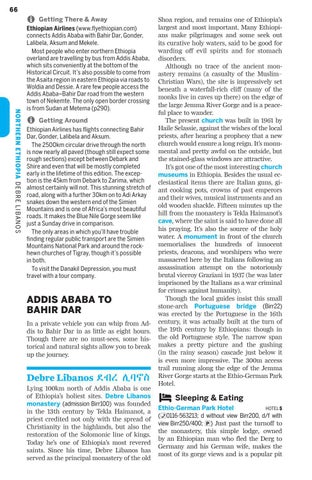66
8 Getting There & Away
NORTHERN ETHIOPIA D A LD S E EB DERI S PEI AN LBIGBAA &BNAEOAT TO S I NBGA H I R DA R
Ethiopian Airlines (www.flyethiopian.com) connects Addis Ababa with Bahir Dar, Gonder, Lalibela, Aksum and Mekele. Most people who enter northern Ethiopia overland are travelling by bus from Addis Ababa, which sits conveniently at the bottom of the Historical Circuit. It’s also possible to come from the Asaita region in eastern Ethiopia via roads to Woldia and Dessie. A rare few people access the Addis Ababa–Bahir Dar road from the western town of Nekemte. The only open border crossing is from Sudan at Metema (p290).
8 Getting Around Ethiopian Airlines has flights connecting Bahir Dar, Gonder, Lalibela and Aksum. The 2500km circular drive through the north is now nearly all paved (though still expect some rough sections) except between Debark and Shire and even that will be mostly completed early in the lifetime of this edition. The exception is the 45km from Debark to Zarima, which almost certainly will not. This stunning stretch of road, along with a further 30km on to Adi Arkay snakes down the western end of the Simien Mountains and is one of Africa’s most beautiful roads. It makes the Blue Nile Gorge seem like just a Sunday drive in comparison. The only areas in which you’ll have trouble finding regular public transport are the Simien Mountains National Park and around the rockhewn churches of Tigray, though it’s possible in both. To visit the Danakil Depression, you must travel with a tour company.
ADDIS ABABA TO BAHIR DAR In a private vehicle you can whip from Addis to Bahir Dar in as little as eight hours. Though there are no must-sees, some historical and natural sights allow you to break up the journey.
Debre Libanos ደብረ ሊባኖስ Lying 100km north of Addis Ababa is one of Ethiopia’s holiest sites. Debre Libanos monastery (admission Birr100) was founded in the 13th century by Tekla Haimanot, a priest credited not only with the spread of Christianity in the highlands, but also the restoration of the Solomonic line of kings. Today he’s one of Ethiopia’s most revered saints. Since his time, Debre Libanos has served as the principal monastery of the old
11-northern-ethiopia-eth5.indd 66
Shoa region, and remains one of Ethiopia’s largest and most important. Many Ethiopians make pilgrimages and some seek out its curative holy waters, said to be good for warding off evil spirits and for stomach disorders. Although no trace of the ancient monastery remains (a casualty of the Muslim– Christian Wars), the site is impressively set beneath a waterfall-rich cliff (many of the monks live in caves up there) on the edge of the large Jemma River Gorge and is a peaceful place to wander. The present church was built in 1961 by Haile Selassie, against the wishes of the local priests, after hearing a prophesy that a new church would ensure a long reign. It’s monumental and pretty awful on the outside, but the stained-glass windows are attractive. It’s got one of the most interesting church museums in Ethiopia. Besides the usual ecclesiastical items there are Italian guns, giant cooking pots, crowns of past emperors and their wives, musical instruments and an old wooden shackle. Fifteen minutes up the hill from the monastery is Tekla Haimanot’s cave, where the saint is said to have done all his praying. It’s also the source of the holy water. A monument in front of the church memorialises the hundreds of innocent priests, deacons, and worshipers who were massacred here by the Italians following an assassination attempt on the notoriously brutal viceroy Graziani in 1937 (he was later imprisoned by the Italians as a war criminal for crimes against humanity). Though the local guides insist this small stone-arch Portuguese bridge (Birr22) was erected by the Portuguese in the 16th century, it was actually built at the turn of the 19th century by Ethiopians: though in the old Portuguese style. The narrow span makes a pretty picture and the gushing (in the rainy season) cascade just below it is even more impressive. The 300m access trail running along the edge of the Jemma River Gorge starts at the Ethio-German Park Hotel.
4 Sleeping & Eating
Ethio-German Park Hotel HOTEL $ (%0116-563213; d without view Birr200, d/f with view Birr250/400; p) Just past the turnoff to
the monastery, this simple lodge, owned by an Ethiopian man who fled the Derg to Germany and his German wife, makes the most of its gorge views and is a popular pit
6/03/2013 3:07:17 PM
